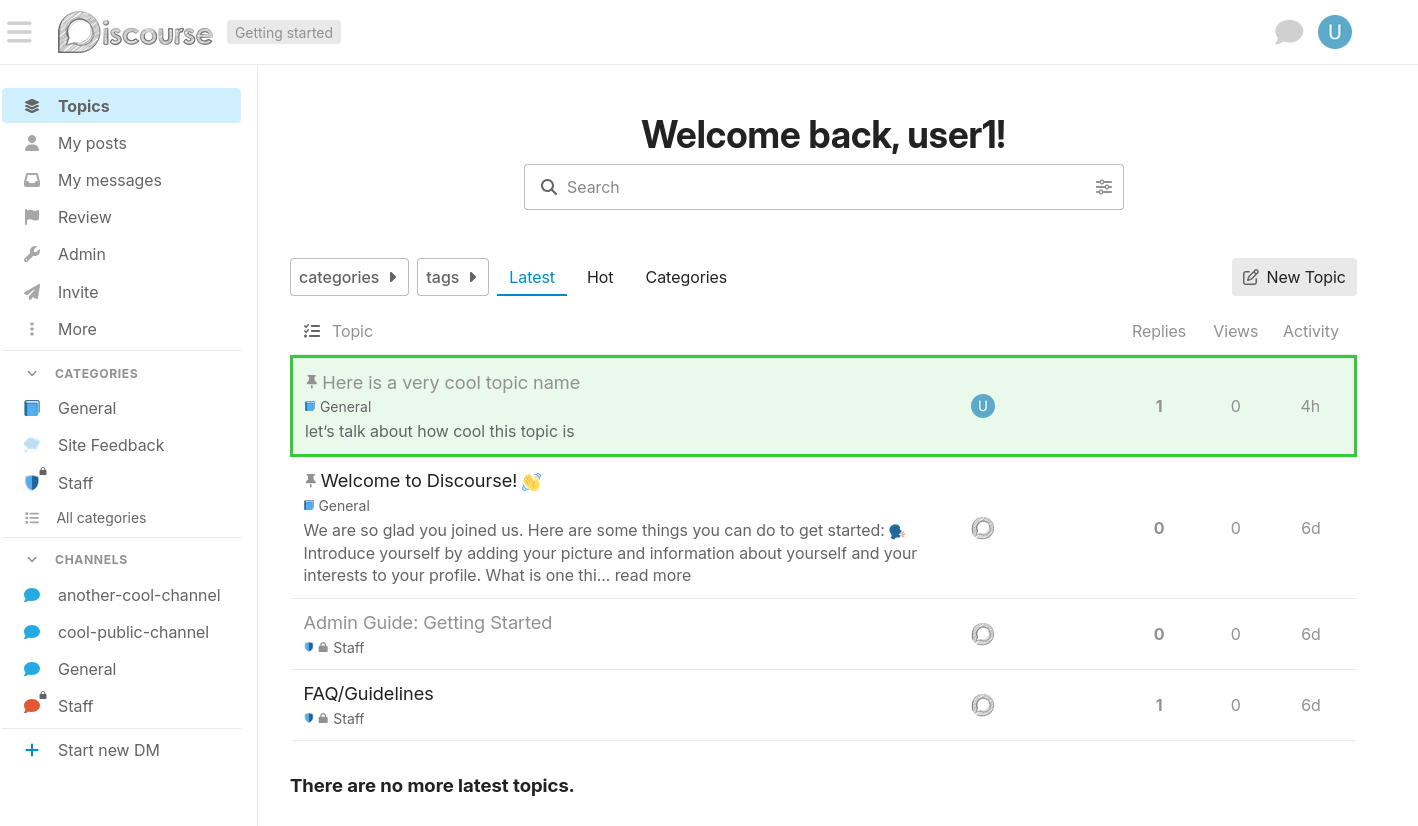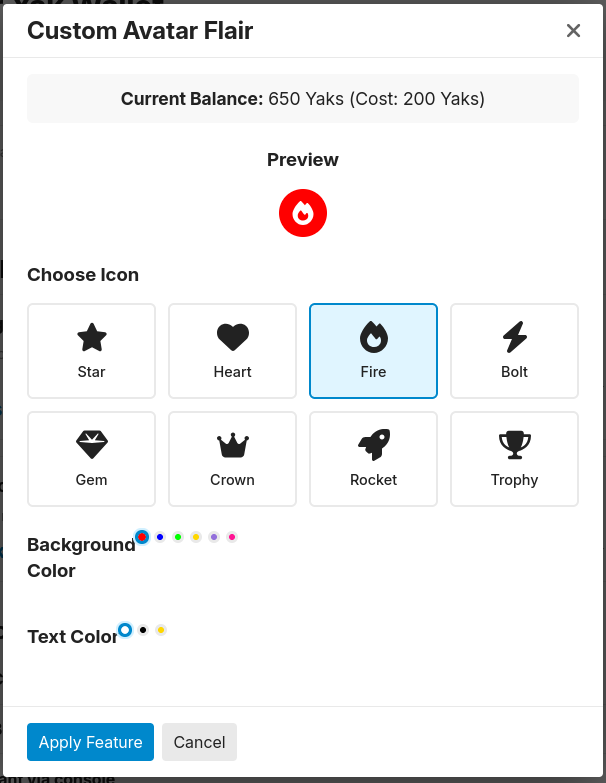Building Yaks: A Virtual Currency System for Discourse (Part 3: Advanced Features)
Part 1 covered the backend architecture and Part 2 covered topic pinning and the expiration system. This post covers two more complex features: topic boosting (pinning topics globally with visual highlighting) and custom avatar flair (letting users customize their forum identity).
Topic Pin vs Topic Boost
The plugin has two topic pinning features with different scopes:
Topic Pin: Pins a topic to the top of its category only. The topic stays at the top of the category page but doesn't appear across other categories. No visual highlighting.
Topic Boost: Pins a topic globally across all categories AND adds a colored border to make it stand out in topic lists. Much more visibility, costs more Yaks.
This post focuses on topic boost, the more powerful and visually striking feature.
Topic Boost: Making Threads Stand Out
Topic boost is a premium feature that pins a topic globally (across all categories) and adds a colored border to make it stand out in topic lists.

Backend: Leveraging Discourse APIs
Discourse has native topic pinning built in. The API is straightforward:
topic.update_pinned(status, global, pinned_until)
Parameters:
status: true to pin, false to unpinglobal: true for global pin (all categories), false for category onlypinned_until: timestamp as string (not Time object)
The service implementation for topic boost:
when "topic_boost"
duration = feature.settings["duration_hours"]&.hours || 72.hours
related_topic.update_pinned(true, true, duration.from_now.to_s)
current_features = related_topic.custom_fields["yak_features"] || {}
current_features["boosted"] = {
enabled: true,
color: feature_data[:color] || "gold",
applied_at: Time.zone.now.to_i,
}
related_topic.custom_fields["yak_features"] = current_features
related_topic.save_custom_fields
This does two things:
- Pins the topic globally for 72 hours using Discourse's native pinning
- Stores visual customization data (color choice) in topic custom fields
Frontend: Value Transformers
To apply CSS classes to boosted topics in topic lists, we use Discourse's value transformer API. This is the modern replacement for the deprecated widget decorators.
api.registerValueTransformer("topic-list-item-class", ({ value, context }) => {
const topic = context?.topic;
if (topic?.yak_features?.boosted?.enabled) {
value.push("yak-boosted-topic");
const color = topic.yak_features.boosted.color || "gold";
value.push(`yak-color-${color}`);
}
return value;
});
The transformer receives a value array and adds CSS classes based on the
topic's custom fields. Optional chaining (?.) prevents errors if the data
is missing.
We also apply styling to the first post in boosted topics:
const topic = helper.getModel().topic;
const topicYakFeatures = topic?.yak_features;
const isFirstPostInBoostedTopic =
post.post_number === 1 && topicYakFeatures?.boosted?.enabled;
if (isFirstPostInBoostedTopic) {
article.classList.add("yak-boosted-topic-post");
const color = topicYakFeatures.boosted.color || "gold";
article.classList.add(`yak-color-${color}`);
}
This gives visual consistency. The colored border appears both in topic lists and on the opening post.
Avoiding N+1 Queries
When adding custom field serialization, you must tell Discourse to preload the data to avoid N+1 query warnings:
TopicList.preloaded_custom_fields << "yak_features" if TopicList.respond_to?(:preloaded_custom_fields)
Without this, accessing topic.custom_fields["yak_features"] in serializers
triggers a database query for every topic in the list. With preloading, all
custom fields load in a single query.
Pin Auto-Dismiss Behavior
Discourse has built-in pin dismissal behavior. When a user visits a pinned
topic, Discourse creates a TopicUser record with cleared_pinned_at
timestamp. For that user, the topic shows as unpinned.
This is intentional design to prevent banner blindness. The topic stays pinned for everyone else, but individual users can dismiss it after viewing. The colored border remains visible to all users regardless of pin state.
CSS Variables for Theme Customization
Originally, colors were hardcoded:
.yak-boosted-topic.yak-color-gold {
border-color: #ffd700;
background: rgba(255, 215, 0, 0.1);
}
This made it difficult for theme authors to customize colors. The fix was CSS variables:
:root {
--yak-color-gold: #ffd700;
--yak-color-gold-bg: rgba(255, 215, 0, 0.1);
--yak-color-blue: #4169e1;
--yak-color-blue-bg: rgba(65, 105, 225, 0.1);
// ...
}
.yak-boosted-topic.yak-color-gold {
border-color: var(--yak-color-gold);
background: var(--yak-color-gold-bg);
}
Now theme authors can override colors without modifying plugin code:
:root {
--yak-color-gold: #ff9900;
--yak-color-gold-bg: rgba(255, 153, 0, 0.15);
}
Custom Avatar Flair: User Identity
Avatar flair is the small badge that appears next to a user's avatar. Normally it's set at the group level (moderators get one badge, admins get another). The custom flair feature lets individual users choose their own icon and color scheme for 30 days.
![]()
The Challenge: Integrating with Existing Components
Discourse has an existing UserAvatarFlair component that reads flair data
from serializers. The component expects certain fields (flair_group_id,
flair_url, flair_bg_color, etc.) and renders accordingly.
Initially, I tried using widget decorators to inject custom data. This hit deprecation warnings. The modern pattern is overriding serializer fields directly.
Serializer Override Pattern
Instead of decorating components, we override the serializer methods:
[:post, :user_card, :post_action_user].each do |serializer_name|
add_to_serializer(serializer_name, :flair_url) do
user = serializer_name == :post ? object.user : object
flair = user.custom_fields["yak_features"]&.dig("flair")
if flair && flair["enabled"]
flair["icon"] # Return icon name like "rocket" or "crown"
else
user.flair_group&.flair_icon || user.flair_group&.flair_upload&.url
end
end
end
This checks user custom fields first. If yak custom flair is present, return that data. Otherwise, fall back to group flair.
Similar overrides for flair_bg_color, flair_color, and flair_name.
This pattern works across all serializers (post, user card, action user)
without touching the component.
The flair_group_id Problem
The UserAvatarFlair component has an early return:
if (!user || !user.flair_group_id) {
return; // No flair rendered
}
Users with custom flair but no group flair would fail this check. The component would exit early and never render anything.
The fix was setting a dummy marker value:
add_to_serializer(serializer_name, :flair_group_id) do
user = serializer_name == :post ? object.user : object
flair = user.custom_fields["yak_features"]&.dig("flair")
if flair && flair["enabled"]
-1 # Dummy value to pass existence check
else
user.flair_group_id
end
end
With flair_group_id set to -1, the component passes the existence check.
It then finds flair_url is set (to the icon name) and renders the custom
flair.
Frontend: Icon and Color Picker

The flair modal presents three selection grids:
const ICONS = ["star", "heart", "fire", "bolt", "gem", "crown", "rocket", "trophy"];
const BG_COLORS = ["#ffd700", "#4169e1", "#dc143c", "#32cd32", "#9370db", "#ff8c00"];
const TEXT_COLORS = ["#ffffff", "#000000", "#ffd700"];
Users click icons to select one, then choose background and text colors. A live preview shows the combination:
<div class="flair-preview">
<span class="user-flair" style={{this.previewStyle}}>
{{d-icon this.selectedIcon}}
</span>
</div>
The preview updates reactively as selections change. Once the user confirms, the modal sends the choices to the backend, which stores them in user custom fields.
Making Feature Cards Clickable
On the wallet page, custom flair is the only feature that needs a modal (icon/color picker). Other features just need a color picker, which is handled inline.
To make the custom flair card clickable, we split the template:
{{#if (eq feature.id "custom_flair")}}
<div class="feature-card clickable" {{on "click" this.openFlairModal}}>
{{! card content }}
</div>
{{else}}
<div class="feature-card">
{{! card content }}
</div>
{{/if}}
Only the custom flair card gets the click handler. Other cards remain static.
This avoids passing undefined callbacks to the {{on}} helper.
What's Next
The plugin now has:
- Post highlighting (colored borders)
- Topic pinning (category-only)
- Topic boosting (global pin + highlight)
- Custom avatar flair (user identity)
Still to implement:
- Post pinning (pin individual post to top of topic)
- Post boosting (increase visibility in feeds)
- Earning system (auto-reward quality posts)
- Guardian authorization (permission checks)
- Admin dashboard improvements
The earning system is the next major piece. Right now, users can only spend Yaks. They need ways to earn them through quality contributions, not just purchases.
Code is on GitHub: ducks/discourse-yaks